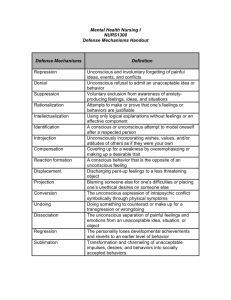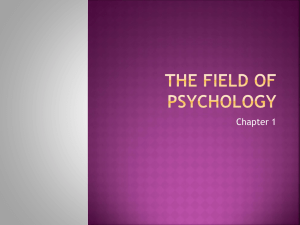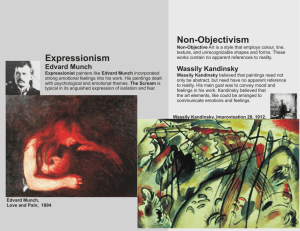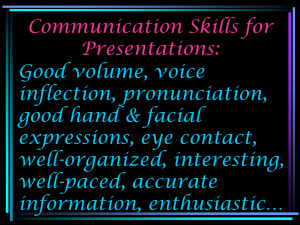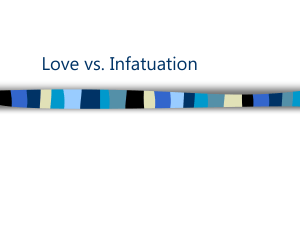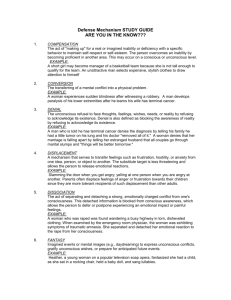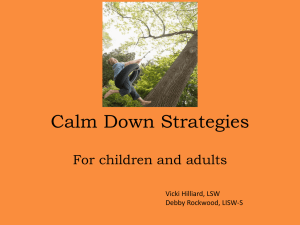Imag(ine)ing our Social Worlds
advertisement
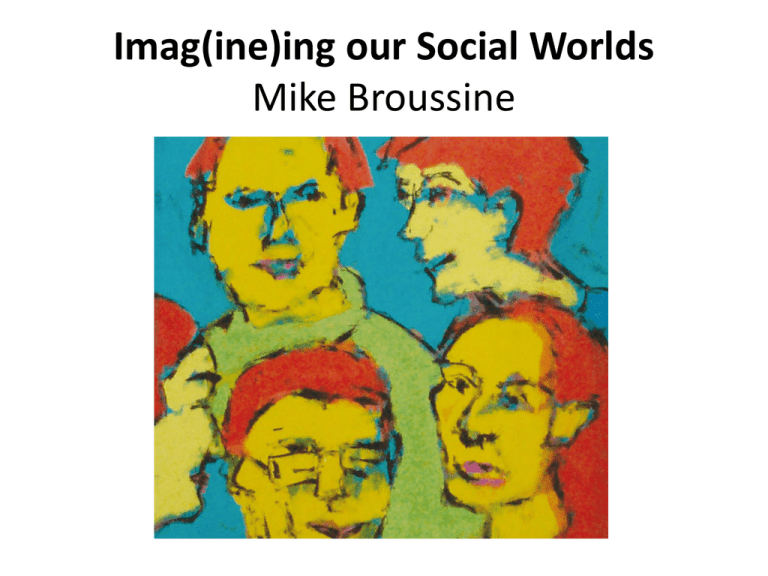
Imag(ine)ing our Social Worlds Mike Broussine Do a drawing ... • Which represents how you see your social world • No artistic skills needed – e.g. matchstick people are OK • Try not to use words or numbers please! • Include yourself in your drawing 2 Edvard Munch: The Scream (1893) Edvard Munch “I was walking along a path with two friends – the sun was setting – suddenly the sky turned blood red. I paused, feeling exhausted, and leaned on the fence – there was blood and tongues of fire above the blue-black fjord and the city. My friends walked on, and I stood there trembling with anxiety – and I sensed an infinite scream passing through nature”. Jackson Pollock, Number 8 (1949) Jackson Pollock • It doesn't matter how the paint is put on, as long as something is said. • The modern artist, it seems to me, is working and expressing an inner world – expressing the energy, the motion and other inner forces. • When I am in my painting, I'm not aware of what I'm doing. The arts intimately connected with feelings • ‘If I could say it in words, I wouldn’t need to dance’ (Isadora Duncan ) • ‘If I could say it in words there would be no reason to paint’ (Edward Hopper) • ‘A work of art which did not begin in emotion is not art’ (Paul Cezanne) • ‘The aim of art is to represent not the outward appearance of things, but their inward significance’ (Aristotle) Art in Human Inquiry - origins • Expressionism - does not seek to portray objective reality but subjective emotional responses that objects and events arouse (e.g. Munch, Kafka, Van Gogh, Brecht) • William Reich (1897-1957): Expressive therapy – constrained emotional energy physical and psychological illness. • Carl Jung (1875-1961): “Primordial” images and symbols – Exploration of psychological difficulties through the interpretation of pictures, dreams and the unconscious. 8 Art Therapy • Term first coined 1942 by artist Adrian Hill (1895-1977) – “the practice of Art seemed to help to take the patient's mind off their illness or injuries and to release their mental distress”. • Underpinned by a belief that clients may selfexpress in situations where it is hard to put feelings into words (Liebmann, 2004) Drawings … • Art therapy uses art as a means of personal expression to communicate feelings rather than aiming at aesthetically pleasing endproducts to be judged by external standards (Liebmann, 2004) • … can be accepted as a valid method of entering a dialogue with the unconscious (Furth, 1988) 10 The power of drawings and art • Approaches person’s or group’s unconscious feelings. • Enables self-expression where it may be hard to put feelings or recollections into words. • Allows expression of complex, subtle and irrational facets of experience (important where “not done” to talk about feelings). • Process is engaging and “hands-on”. • Useful when not wanting to impose analytical framework on people, but to encourage spontaneity/creativity in expression. • Encourages play, fantasy and reverie to access pre/unconscious material. 11 12 13 14 15 Specific features in drawings • • • • • • • • • • PEOPLE – hands, faces, positioning PORTRAYAL OF ORGANISATION MISSING ITEMS SIZE OF IMAGES DISTORTIONS REPETITIONS AND SHADING MOVEMENT and JOURNEY METAPHOR ABSTRACT IMAGES HOW SPACE USED 16 References & Bibliography • Behr, S. (1999) Expressionism, Cambridge University Press • Broussine, M. (ed.), 2008, Creative Methods in Organizational Research, Sage Publications • Furth, G.M., 1988, The Secret World of Drawings - Healing Through Art, Sigo Press. • Hogan, S., 2001, The History of Art Therapy, Jessica Kingsley Publications • Liebmann, M. (2004) Art Therapy for Groups – A Handbook of Themes, Games and Exercises, Brunner-Routledge • Rubin, J.A. (Ed.) (2001) Approaches to Art Therapy – Theory and Technique, New York, Brunner-Routledge MPB, 20/10/2011 17
